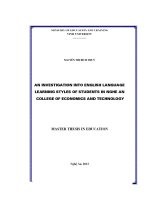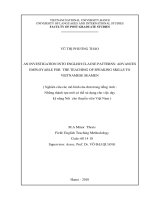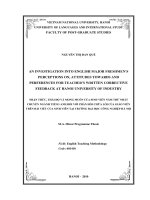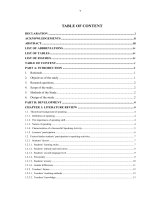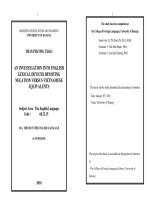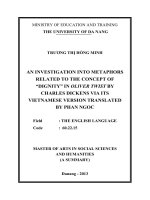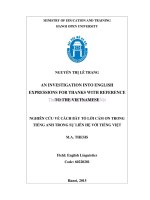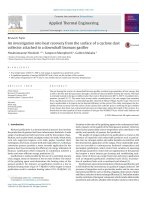An investigation into translating stylistic devices in cung đường vàng nắng by duong thuy into english in in the golden sun by elbert bloom (tt)
Bạn đang xem bản rút gọn của tài liệu. Xem và tải ngay bản đầy đủ của tài liệu tại đây (783.44 KB, 25 trang )
THE UNIVERSITY OF DANANG
UNIVERSITY OF FOREIGN LANGUAGE STUDIES
NGUYỄN THỊ HUYỀN NGỌC
AN INVESTIGATION INTO TRANSLATING SDS IN “CUNG
ĐƯỜNG VÀNG NẮNG” BY DUONG THUY INTO ENGLISH
IN “IN THE GOLDEN SUN” BY ELBERT BLOOM
Major: ENGLISH LINGUISTICS
Code : 822.02.01
MASTER THESIS IN
FOREGN LANGUAGES, LITERATURE AND CULTURE
(A SUMMARY)
Danang, 2018
This thesis has been completed at University of Foreign
Language Studies, The University of Da Nang
SUPERVISOR 1: NGUYỄN THỊ HUỲNH LỘC, Ph.D.
SUPERVISOR 2: LÊ TẤN THI, Ph.D.
Examiner 1 : Assoc.Prof.Dr. Trần Hữu Phúc
Examiner 2 : Assoc.Prof.Dr. Trần Văn Phước
The thesis was orally defended at the Examining Committee
Time : 19th October, 2018
Venue : University of Foreign Language Studies
The University of Da Nang
This thesis is available for the purpose of reference at :
- Library of University of Foreign Language Studies,
The University of Da Nang.
- The Information Resources Center, The University of Da Nang.
1
Chapter one
INTRODUCTION
1.1. RATIONALE
Duong Thuy is currently an author loved by young generation.
Her stories and novels have been interested by readers over the
countries. Her books can be seen in the offices, on the shelves in the
apartments, on buses on the way to offices or back home. Many of
her books have been translated into English such as Oxford yêu
thương (Beloved Oxford) in 2008, Nhắm mắt thấy Paris (Paris
Through Closed Eyes) in 2010, Tôi nghĩ tôi thích nước Mỹ (Across
America) in 2017. Particularly, her new edition “Cung đường vàng
nắng” (In the Golden Sun) an interesting book hunted by the young
people. This novel has been translated into English by Elbert Bloom,
a native translator.
I am now a teacher at a vocational school and have done an
extra at English center. In teaching English I myself have faced a lot
problems in terms of translation, especially the translation of some
Vietnamese structures in general and Vietnamese stylistic devices in
particular into English. In addition, I am now attending a Master
course in English linguistics and have acquired knowledge in terms
of linguistics in general as well as in translation particular. This is an
opportunity for me to apply what have been learned into the research.
. For all above reasons, I would like to choose “An Investigation into
Translating stylistic devices in ‘Cung đường vàng nắng’ by Duong
Thuy into English in ‘In the Golden Sun’ by Elbert Bloom” for the
thesis topic. The research is conducted with the purpose of applying
2
the result of the study in learning and teaching as well as translation
of English.
1.2. AIMS AND OBJECTIVES
1.2.1 Aims
The mainly aim of this research is to investigate the stylistic
devices in “Cung đường vàng nắng” by Duong Thuy and analyze the
translation of these stylistic devices into English in its English
version “In the Golden Sun‟ ” by Elbert Bloom with the hope of
raising learner‟s knowledge of stylistic devices and helps the
Vietnamese learner of English understanding in terms of rending the
stylistic devices from a source language to the target one.
1.2.2. Objectives
To achieve the aims of the study, the following objectives are
intended to:
- Identify, describe and analyze the SDs used in "Cung đường
vàng nắng" and their English translational equivalents.
- State translation procedures used for translating Vietnamese
SDs in English.
- Suggest some implications for translating SDs from SL to
target one .
1.3. SCOPE OF THE STUDY
This study focus on translating Vietnamese SDs in "Cung
đường vàng nắng" by Duong Thuy into English in “In the golden
sun” by Elbert Bloom. The SDs concerned are simile ane ellipsis.
The two SDs in the English version will be investigated in order to
find out the translation procedures used to render these SDs into
English.
3
1.4. RESEARCH QUESTIONS
To fulfill the objectives mentioned above, the study tries to seek
the answer to the following questions:
a. What are Stylistics devices i.e. simile and ellipsis found in
"Cung Đường Vàng Nắng"?
b. How are these Stylistics devices translated into English in
term of translation procedure?
1.5. ORGANIZATION OF THE STUDY
This study consists of 5 main chapters as follows:
- Chapter 1:“Introduction”
- Chapter 2: “Literature review”
- Chapter 3: “Research Methods”
- Chapter 4: “Findings and Discussion”.
- Chapter 5: “Conclusion and Implications
4
Chapter two
LITERATURE REVIEW
2.1. REVIEW THE PREVIOUS STUDY
In Vietnamese as well as in English language, some researches
on stylistic devices and translation of stylistic devices can be found.
They include “99 phương tiện và biện pháp tu từ tiếng Việt” by Đinh
Trọng Lạc (1996) that gives the definition, functions, and
classification of stylistic devices through specific examples,
“Stylistics” by Galperin, I. R. (1977) which defines and classifies
stylistic devices to find out its semantic, syntactic as well as
pragmatic features or “A Text book of translation” by Newmark, P.
(1988) mentioning theory of translation, translation methods, and
procedures for translating metaphor. In addition, some master theses
in the University of Danang will be used as reference resources. In
reference with the dissertation entitled “An Investigation into
Stylistic Devices in “The Life We Were Given” by Dana Sachs and
Their Vietnamese Translational Equivalents” conducted by Nguyen
Thi Thy Tho (2014), the three commonly-used stylistic devices:
metaphor, metonymy and smile and translation procedures used for
rendering stylistic devices from English into Vietnamese was taken
in consideration.
All of these studies could be used as the useful materialism of
this thesis. However, there has been so far no research into the SDs
used "Cung Đường Vàng Nắng” by Dương Thụy and its English
version. This is the reason why I have decided on this thesis entitled.
5
2.2. THEORETICAL BACKGROUND
2.2.1. Stylistics devices
2.2.1.1. Stylistics
As dealing with the term „stylistics‟, many linguists have
given out a variety of definitions:
According to Galperin, stylistics is a branch of general
linguistics, which deals with the investigation of two independent
tasks, Galperin, I. R. (1977:9)
a. Stylistics studies the special media of language which are
called SDs and expressive means.
b. Stylistics studies the types of texts which are distinguished
by the pragmatic aspect of the communication and are called
functional styles of language.
2.2.1.2. Definition of stylistics devices
According to Galperin [p.9]: “It is a conscious and
intentional intensification of some typical structural and/or semantic
property of a language unit (neutral or expressive) promoted to a
generalized status and thus becoming a generative model”.
According to Galperin “stylistic is a branch of general
linguistics which deals mainly with the functional styles of
language and the special media of language which secure the
disable effect of the utterance are called the SDs and expressive
means”.
As the definition on Wikipedia, “Stylistic device is
figurative language in the form of a single word or phrase. It can be a
special repetition, arrangement or omission of words with literal
meaning, or a phrase with a specialized meaning not based on the
literal meaning of the words.” .
6
In this study, the researcher employed SDs theory (Galperin,
1977 and Đinh Trọng Lạc, 1999) for describing SDs in terms of
semantic features.
2.2.1.3. Functions of stylistic devices
According to Katie Wales in A Dictionary of Stylistics, 2nd
ed. (Pearson, 2001), "The function of most SDs is not simply to
describe the formal features of texts for their own sake, but in order
to show their functional significance for the interpretation of the text;
or in order to relate literary effects to linguistic 'causes' where these
are felt to be relevant."
The Greeks consider rhetoric functions as a method of
communication, spoken or written, between people as they seek to
determine truth or fallacy in real.
2.2.1.4. Classification of stylistic devices
According to I.R Galperin, SDs are classified into three
kinds based on their specific features and functions. They are:
Phonetic stylistic devices
Lexical stylistic devices
Syntactical stylistic devices
2.2.2. Simile
2.2.2.1. Definition of Simile
According to Galperin “Simile is a figure of speech in
which an explicit comparison between two things, two different
entities on the basis of a common feature, using words such as like,
as, than, similar to, resemble or seem”.
Definition of simile in English by Oxford dictionaries :A
figure of speech involving the comparison of one thing with another
thing of a different kind, used to make a description more emphatic
7
or vivid (e.g. as brave as a lion)
In Vietnamese, Đinh Trọng Lạc proposes a definition of
simile in his book “99 phương tiện và biện pháp tu từ tiếng Việt”:
“So sánh c n gọi là so sánh h nh nh, là m t biện pháp tu từ ngữ
nghĩa, trong đ người ta đ i chiếu hai đ i tư ng khác loại c a th c tế
khách quan không d ng nhất với nhau hoàn toàn mà ch c m t n t
gi ng nhau nào đ , nh m di n t b ng h nh nh m t l i tri giác mới
m v đ i tư ng.” 26, p.129]
2.2.2.2. Classification of Simile
There are four types of similes:
- Human beings as subject in similes
- Abstract concepts as subject in similes
- Specific things as subject in similes
- Animals as subject in similes
2.2.3. Ellipsis
Galperin, I. R. (1977) stated that Ellipsis is a typical
phenomenon in conversation, arising out of the situation. We
mentioned this peculiar feature of the spoken language when we
characterized its essential qualities and properties.
This particular model of sentence suggests the author‟s
personal state of mind, viz his indignation at the shameless speech of
the justice. It is common fact that any excited state of mind will
manifest itself in some kind of violation of the recognized literary
sentence structure.
2.2.4. Theory of Translation
2.2.4.1 Definitions of translation
Some authors have given different definitions of translation:
8
In the book “A Linguistic Theory of Translation”, Catford
4] gives out his point of view: „translation is not a dangerous
technique in itself provided its nature is understood, and its use is
carefully controlled and translation is in itself a valuable skill to be
imparted to students.
Dubois (1973, P.22) states that “Translation is the expression
in another language (or TL) of what has been expressed in another,
SL, preserving semantic and stylistic equivalences.” 6]
Another author, Vũ Văn Đại p.25] claims that “there is an
unequivalence in culture of translators and original texts, so in order
to become good translators, it is very necessary to enrich the cultural
and national knowledge of the TL.”
2.2.4.2. Literary translation
2.2.4.3. Types of equivalence
2.2.4.4. Translation methods
2.2.4.5. Translation procedures
2.2.5. Overview of Co-translators and the Book
2.2.5.1. Duong Thuy - The author
2.2.5.2. Elbert Bloom - The native translator
2.2.5.3. “Cung đường vàng nắng”
9
Chapter three
RESEARCH METHODS
3.1. METHODOLOGY
In order to reach the goal of the study, we carried out our
investigation based on the qualitative and quantitative methods.
The combination of qualitative and quantitative approaches
was applied to collect, classify the data on Vietnamese SDs (simile
and ellipsis) in "Cung đường vàng nắng" by Duong Thuy and their
English translational equivalent in “In the Golden Sun” by Elbert
Blloom and point out the translation procedures for rendering these
SDs into English.
3.2. SAMPLING
The samples that include SDs; i.e. simile and ellipsis in Cung
đường vàng nắng‟ and their English translational equivalents in „In
the Golden Sun‟ will be collected.
3.3. DATA COLLECTION
In this research, the samples of SDs in the SL are collected
together with their English translational equivalent are sentences,
clauses and phrase that will be collected from " Cung đường vàng
nắng " by Duong Thuy and their English translational equivalents
in “In the golden sun” by Elbert Bloom .
With the investigation of the SDs, I collect 206 samples
including 103 samples in Vietnamese and the same quantity in
English both for simile and ellipsis. Based on theoretical
background, we picked out and classified them into right
categories.
10
3.4. DATA ANALYSIS
- Data analysis is carried out based on the theories of SDs and
the theories of translation, thus, data analysis is conducted with the
following steps:
- Collecting samples in “Cung đường vàng nắng” by Duong
Thuy and their English version in “In the golden sun” by Elbert
Bloom.
- Identifying and grouping into categories depending on the
SDs used in “In the golden sun” by Duong Thuy.
- Analyzing to find out how each stylistic device is
translated into English according to translation procedures in their
English version.
- Suggesting some implications for translation, studying as
well as teaching English.
3.5. RELIABILITY AND VALIDITY
Chapter four
FINDINGS AND DISCUSSION
4.1.
ENGLISH
TRANSLATIONAL
EQUIVALENTS
OF
VIETNAMESE SIMILES
4.1.1. English translational equivalents of the structure of
Vietnamese simile device „như‟.
11
Table 4.1. English Structural Equivalents of the Vietnamese Simile
Device Structure „như‟.
Vietnamese Simile
English Syntactic
Translation
Device Structures
Equivalents
Procedures
V(P)+ như + N(P)
V(P) + Like + N(P)
V(P) + như thể+ Cl
V(P)+ as though + Cl
Adj + như + Cl
as Adj as+ Cl
V(P) + như + NP
V(P) + like + NP
V(P)+ như + Pro
V(P)+ like + Pro
V + như + Cl
V + like + N(P)
V(P) + như + NP
V(P) + like + PP
Adj + như + PP
V(P) +like + NP
N + dường như + Pro
There appear V(P)
Literal
Ø + dường như + S+ seemed + Cl
V(P)
V + như + Pro
V + That + N
Adj + như + Pro
as + Adj + as + Cl
Adj +như + N
Adj + like + adv
VP + như + Adv
VP+ as + Adj
Adj + như + NP
as Adj as+ NP
Adj + như + N(P)
VP + Ad j + Ø
Shifts
Reduction
12
N(P)+ như + Pro
N(P) + Ø
VP+ như + PP
VP + Ø + PP
V(P) + như + Pro
Adj + Ø
N(P) + như + N(P)
N(P) + Ø
V + như + Cl
V + as though + Cl
Adj + như + Adv
VP + like + Cl
VP+ như + Cl
VP + as if + VP
Adj + như thể + Cl
Adj + as though + Cl
VP + như + N
Cl + Which Cl
VP + như + Cl
VP + While Cl
Expansion
Synonym
Couplets
4.1.2. English translational equivalents of the structure of
Vietnamese Simile device „hơn‟
Table 4.2. English translational equivalents of the Vietnamese simile
device structure „hơn‟
Vietnamese Simile
English Syntactic
Translation
Device Structures
Equivalents
Procedures
Adj + hơn + (NP)
Adj-er + (NP
Adj + hơn + pro
more than + N(P)
V + hơn + Pro
more (Adv) than + Pro
Adj + hơn
more Adj
Adj + hơn
Adj-er
Adj + hơn + pro
(Cl) +Ø + Adv
Adj + hơn
Adj+Ø
Shifts
Literal
Reduction
13
4.1.3. English translational equivalents of the structure of
Vietnamese simile device „nhất‟
Table 4.3. English translational equivalents of the Vietnamese simile
device structure „nhất‟
Vietnamese Simile
English Syntactic
Translation
Device Structures
Equivalents
Procedures
Adj + nhất
N + Adj +
nhất
The most Adj
Shifts
The Adj-est + N
Adj + nhất
The Irregular superlative
Adj + nhất
V + the most
Literal
4.1.4. The occurrence frequencies of procedures for
English translational equivalents of Vietnamese simile structures
Table 4.4. The occurrence frequencies of procedures for English
translational equivalents of the Vietnamese simile structures
Translation
Occurrences
Rates
Literal
11
27.5%
Shift
15
37.5%
Reduction
8
20%
Expansion
2
5%
Synonym
2
5%
coupletss
2
5%
Total
40
100%
Procedures
4.1.5. Summary
With regard to the occurrence frequencies of translation
14
procedure are used to render the structure of Vietnamese similes như,
hơn and nhất into English, the shift translation procedure accounts for
the highest proportion of 37.5%. The second rank is literal that has
the rate of 27.5%. The translation procedure reduction amounts to
20%. The procedures expansion, synonym and couplets share the
lowest percentage of 5 %.
It can be predicted that shifts is one of the effective ways that
can be applied for transferring a Vietnamese simile structure into
English one. As a result, the least favorable translation procedure
which is employed in order to translate a Vietnamese simile structure
into English could be expansion, synonym and couplets. .
4.2. ENGLISH TRANSLATIONAL EQUIVALENTS OF THE
VIETNAMESE ELLIPSIS
4.2.1. English translational equivalents of Vietnamese
adjective phrases as ellipsis.
Table 4.5. English translational equivalents of Vietnamese adjectives
as ellipsis.
Vietnamese
Adjectives as
Ellipsis
English Syntactic
Equivalents
Translation
Procedures
Adj P
Adj P
Literal
Adj P
Simple sentence
Shifts
Adj P
Simple sentence
Paraphrase
VP
Synonym
Adj P
Simple sentence
Adj P
Simple sentence
Expansion
Adj P
Ø
Reduction
15
4.2.2. English translational equivalents of Vietnamese verb
phrases as ellipsis.
`Table 4.6. English translational equivalents of Vietnamese verb
phrases as ellipsis
Vietnamese Verbs English
as Ellipsis
Syntactic Translation
Equivalents
Procedures
VP
Simple sentence
VP
Complex sentence
Synonym
Simple sentence
Complex sentence
VP
VP!
Paraphrase
Compound sentence
V + Question word?
Negative word
VP
VP
VP?
VP?
Couplets
Literal
Adj
VP
Compound sentence
Complex sentence
Shifts
Simple sentence
Complex sentence
VP
Simple sentence
VP
Ø
Compensation
VP
VP
Complex sentence
Tag question
Expansion
16
4.2.3. English translational equivalents of Vietnamese noun
phrases as ellipsis
Table 4.7. English translational equivalents of the Vietnamese noun
phrases as ellipsis
Vietnamese Noun
English Syntactic
Translation
Phrases as Ellipsis
Equivalents
Procedures
NP
Literal
NP
Simple sentence
NP
NP
Shifts
NP
Sentence?
Expansion
Negative word
Simple sentence
Synonym
NP?
Sentence
Paraphrase
NP?
Sentence
Reduction
NP
Yes/no question
Couplets
4.2.4. English translational equivalents of the Vietnamese
clauses as ellipsis
Table 4.8. English translational equivalents of the Vietnamese
clauses as
Vietnamese Clauses English
as Ellipsis
Cl
ellipsis
Syntactic Translation
Equivalents
Cl
Simple sentence
Complex sentence
Cl
Cl
Cl
Procedures
Shifts
Paraphrase
Compound sentence
Simple sentence
Compound sentence
Simple sentence
Literal
Synonym
17
Cl
Cl
Reduction
Cl
Compound sentence
Expansion
4.2.5. English translational equivalents of the Vietnamese
prepositional phrases as ellipsis.
Table 4.9. English translational equivalents of Vietnamese
prepositional phrases as ellipsis.
Vietnamese
Prepositional
Phrases as Ellipsis
English
Syntactic Translation
Equivalents
Procedures
simple sentence
PP
PP
Synonym
Literal
4.2.6. English Translational Equivalents of Vietnamese
Question Words as Ellipsis
Table 4.10. English translational equivalents of Vietnamese question
words as ellipsis
Vietnamese Question English
Words as Ellipsis
Question word?
Syntactic Translation
Equivalents
Procedures
Question word?
Literal
Interrogative
sentence?
Wh word?
Ø
Question word + Adv?
Question word + Ø
Question word?
Question word?
Elliptical Question?
Question word?
Interrogative
Paraphrase
Reduction
Synonym
sentence
Question word?
Expansion
18
4.2.7. The occurrence frequencies of procedures for English
translational equivalents of Vietnamese ellipsis structures
Table 4.11. The occurrence frequencies of procedures for English
Translational equivalents of the Vietnamese ellipsis
Translation
Occurrences
Rates
Synonym
15
23.8%
Literal
10
15.9%
Paraphrase
9
14.3%
Expansion
7
11.1%
Reduction
7
11.1%
Shifts
11
17.4%
Compensation
2
3.2%
Couplets
2
3.2%
Total
63
100%
Procedures
4.2.8. Summary
In reference to the occurrence frequencies of translation
procedures that are employed to translate the Vietnamese ellipsis
constructions into English, it is found that the largest rate is synonym
which makes up 23.8%.. The shifts procedure takes the second rank
is with the proportion of 17.4%. The procedure literal is lower than
shifts which make up 14.3%. The procedure paraphrase is slightly
lower than literal which makes up 9.8%. The other two translation
procedures, i.e. expansion and reduction share the same rate of
11.1% for each case.
The lowest rate of 3.2% is found in the
translation procedure of couplets and compensation. It can be
19
concluded that the least favorable translation procedure which is
employed in order to translate a Vietnamese ellipsis structure into
English can be couplets. Otherwise, one of the most effective ways
that can be applied for transferring a Vietnamese ellipsis structure
into English one is synonym.
20
Chapter five
CONCLUSIONS AND IMPLICATIONS
5.1. CONCLUSIONS
Furthermore, thanks to the translation procedures suggested
by Peter Newmark [21], this research also has analyzed the
translation of simile from Vietnamese into English in “ Cung duong
vang nang”. Six procedures of translation were applied for simile in
this study. Their order is arranged from the highest frequency to the
lowest one as bellowing:
1.
2.
3.
4.
Shifts
Literal translation
Reduction
Synonym, Expansion and couplets
And eight procedurés have been found to be used when
examining the translation of ellipsis in “Cung duong vang nang”.
They are classified as following:
1.
2.
3.
4.
5.
6.
Synonym
Shifts
Literal translation
Paraphrase
Expansion and reduction
Couplets and compensation
5.2. IMPLICATIONS OF THE STUDY
We believed that this study will help a useful contribution to
teaching and learning of simile and ellipsis in Vietnamese and
translation of SDs into English. Besides, basing on the result of the
research, we would like to give some suggestions and implication for
teaching, learning and translating language.
21
5.2.1. Implications for Language Teaching and Learning
5.2.1.1. For language teachers
- Firstly, teaching English will have the further references
about frequently used SDs and their translation procedures from
Vietnamese to English on arranging to teach their language learners.
- Moreover, teachers should also provide learners more chance
to read, analyze and compare SDs used in Vietnamese and English
works and the translation methods of two languages.
- Then, They will give some interesting advices to learners to
approach SDs employed in Vietnamese and English literary works .
- Finally, teacher should advise their students to write the
essays or communicate using SDs on behalf of the normal style or
sometimes teaching English should create the excitement by using
SDs in communicating lessons in their classes.
5.2.1.2. For language learners
- Firstly, language learners will widen their knowledge of SDs.
So, they could understand and use them appropriately and efficiently
in real works.
- Besides, through this research, it will help English learners
enrich their knowledge of SDs. So, the learners will realize the main
differences between two languages to help them do their translation
tasks much more easily and efficiently.
- Moreover, Based on this study, learning language is
encouraged to employ the SDs commonly in using language to make
the use of their language more attractively and efficiently.
- Finally, learners should also read the SL as well as
translational language of the SDs to improve their language and
translation capabilities.
22
5.2.2. Implications for Translating
Therefore, based on this study, I have some applications for
translating as following:
- First of all, translators and interpreters understand clearly
about each SDs to select the suitable translation methods and
procedures to achieve a good translational equivalent.
- Secondly, they knew how to translate from Vietnamese to
English and should always know about language and culture of the
SL and the Tl to achieve the effective and successful translational
version.
- Finally, people who are good translators should study and
self - educate himself/ herself as soon as possible for their own better
skills and ability in the field.
5.3. LIMITATIONS OF THE STUDY
In fact, there are many approaches which we chose to
analyze the data in this research. However, because of the shortage of
sources of materials related to the topic, limited time and ability of
the researcher as well as other outside factors, we only focus on
analyzing two SDs (simile and ellipsis) and point out the procedures
for translating of these SDs in “Cung duong vang nang” by Duong
Thuy and the English translational equivalent “In the golden sun” by
Elbert Bloom. Therefore, our study also expresses some limitations
and weaknesses.
Therefore, we hope that teachers and friends and those
who take interest in this thesis will give very grateful ideas,
comments, and advice to help me further development of this
study better.
23
5.4. SUGGESTIONS FOR FURTHER RESEARCH
My research commonly focused on the most typical used
SDs in “Cung duong vang nang” by Duong Thuy and the translation
procedures into English of these SDs. Therefore, for further research,
I would like to suggest some studies, including:
- An investigation into the syntactic features of SDs in
“Cung duong vang nang” by Duong Thuy and its translation version.
-
An investigation into the pragmatic features of SDs
in“Cung duong vang nang” by Duong Thuy and its translation
version.

